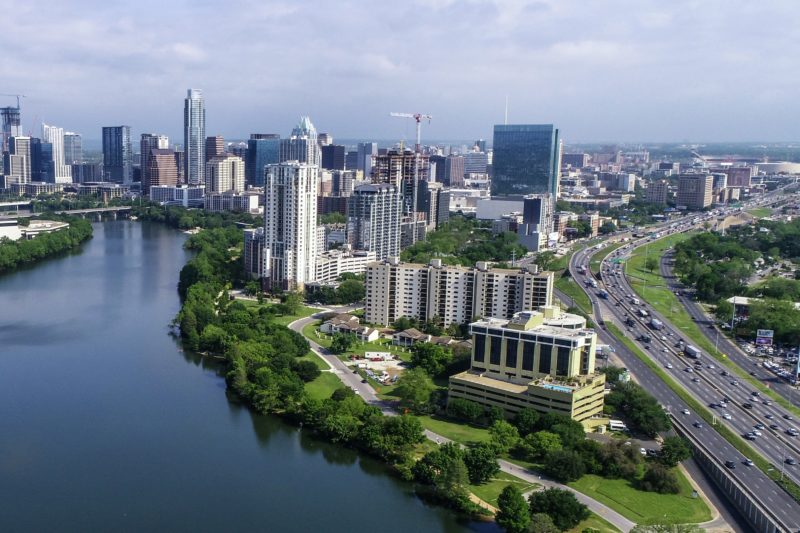I-35 Expansion Plan Sparks Discussion Over Historical Barrier
By Minka Atkinson
Reporting Texas

Clearing neighborhoods and bulldozing businesses to expand an existing concrete barrier that has divided communities or digging deep into a reimagined urban core;
these are the choices up for debate in the struggle to find a plan for modernizing I-35 through the center of Austin.
Following a public comment period that ended Sept. 24, the Texas Department of Transportation is evaluating community response to its plan to widen I-35 between Ben White Boulevard and State Highway 71 to the south and U.S. Highway 290 East to the north.
The plan, called the Capital Express Central project, would add two non-tolled high-occupancy vehicle managed lanes in each direction. These lanes would be reserved for carpools, emergency services and transit vehicles.
“By 2045, the population in the Austin region is expected to double, which means congestion will continue to worsen unless we do something about it,” the Capital Express Program proclaims on its website.
Construction on the Central project is expected to cost around $4.9 billion and will be funded by state and federal gas and tax money, project officials say. In comparison, the North and South portions of the project are expected to cost $400 million and $300 million respectively.
Because of its scope, the plan has met with opposition from many Austin residents, especially those living along I-35. The Capital Central Express project would require TxDOT to acquire and demolish around 150 homes and businesses to create room tor the new construction, according to Addie Walker, a member of Reconnect Austin, one of several groups campaigning for alternatives to the existing expansion plan.
“We are fighting it tooth and nail, trying really hard to get the community involved,” Walker said.
Reconnect Austin’s vision is to lower I-35 through central Austin, cap it and build a new boulevard on top. The boulevard would connect to the existing city grid, allowing for easier east-west travel through Austin, and provide space for bike and pedestrian infrastructure, Walker said.
“When (you’re) taking local trips, and not regional trips, you don’t really need to get on the highway, but because it cuts through the city grid, a lot of people feel like they need to get on the highway, or they have to to get certain places,” Walker said. “If you reinstitute a grid, and you put those highway lanes below ground, it’s a lot easier to get places.”
In its current form, I-35 has served for decades as a physical barrier, unofficially reinforcing the historical segregation between white neighborhoods to the west and Hispanic and Black neighborhoods to the east by making travel between them difficult and even dangerous for pedestrians and bikers. Reconnecting the city grid rather than further expanding I-35 would be a step toward undoing that segregation, said Kathie Tovo, Austin City Council District 9 member.
“There are some people who have been invested in it for a very long time, who are really interested in creating that better connection between East Austin and Central Austin, and see I-35 for what it is: a really visible symbol of planning tools and a system that was deeply rooted in racist practices,” said Tovo, whose district includes a large portion of I-35.
In addition to making Austin more connected, alternative plans like those suggested by Reconnect Austin or Rethink35, which advocates for entirely replacing I-35 with a boulevard rather than capping it, would also lower noise pollution and make I-35 less unpleasant to be near, Rethink35 cofounder Adam Greenfield said.
“I very viscerally feel the impact of I-35,” Greenfield said. “I live about four blocks to the east of it. I can hear it in bed, I hear it in my yard. I hear it all day, every day. I cross it frequently. It’s scary. It’s unpleasant, just as a quality-of-life part of Austin.”
TxDOT stated on their project fact sheet that expanding I-35 is necessary in order to reduce congestion, as I-35 is currently ranked the most congested highway in Texas. Furthermore, I-35 does not meet current federal and state design standards, according to the transportation department.
However, past evidence has shown that widening highways does not necessarily reduce congestion in the long term. This is because adding space for more cars encourages more people to use the highway, creating more traffic in a phenomenon known as induced demand, according to a September 2021 Bloomberg article.
TxDOT has publicly acknowledged that induced demand means I-35 will continue to be congested after its expansion, but said that this is acceptable because it means fewer trips are bleeding out onto nearby city streets, according to Walker.
“That’s their goal, is to take trips off of city streets and onto the highway, and that just isn’t something that I think we should be fighting for,” Walker said.
Groups like Reconnect Austin and Rethink35 argue that traffic could more effectively be reduced by providing other options for local travel, such as public transit and safe biking and walking routes, and by encouraging long-distance travelers to use other routes such as State Highway 130.
“We know from many examples that when you change the environment, people change their habits; people adjust to the environment,” Greenfield said. “And the truth is that with a multimodal boulevard with dedicated space for buses, trains, walking, biking, that people would almost certainly get to where they’re going more quickly.”